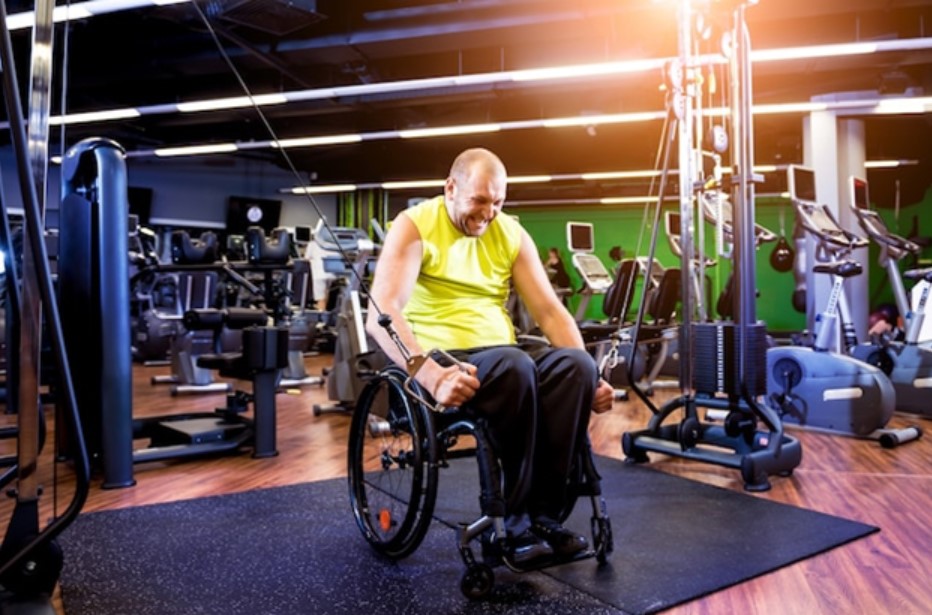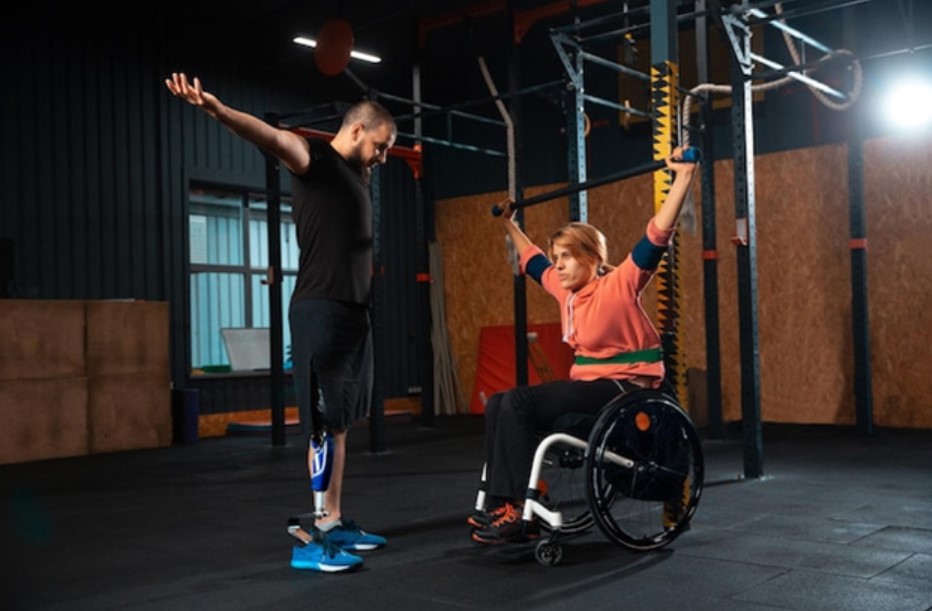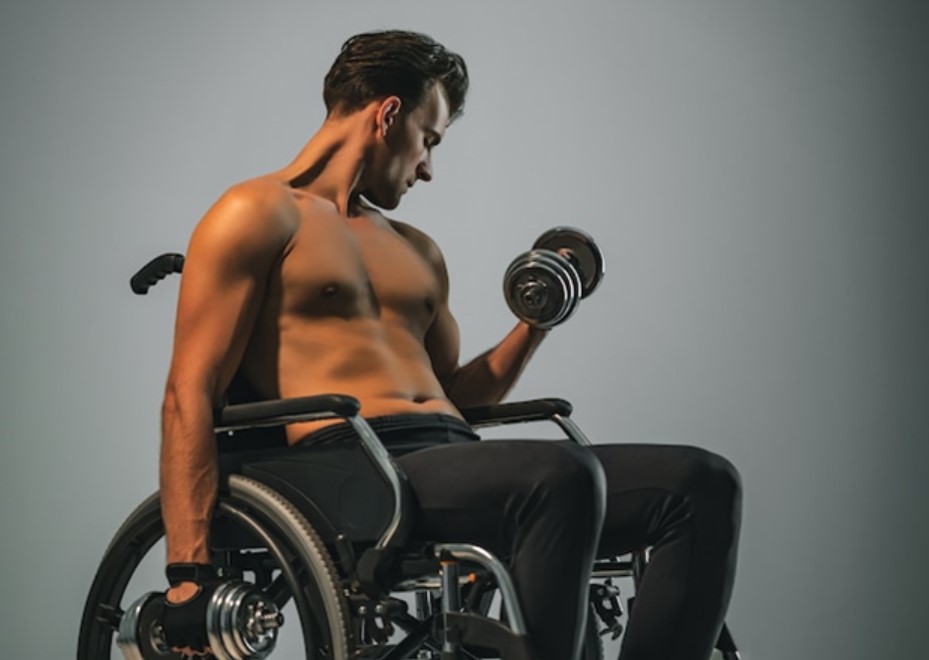This post will go over important wheelchair bodybuilding recommendations such as correct diet, aerobic routines, resistance training, and how to overcome particular hurdles. We will also share motivational stories from real-life wheelchair bodybuilders who have beaten the obstacles and earned a name for themselves in the fitness industry.
Building your body is about more than simply physical strength. It also requires mental toughness, persistence, and the ability to overcome hurdles. Contrary to popular opinion, being restricted to a wheelchair does not preclude you from meeting your fitness objectives. There are numerous inspiring instances of people who have used a wheelchair to overcome physical obstacles and achieve great success in bodybuilding.
Essential Tips for Wheelchair Bodybuilding
- Proper Nutrition for Wheelchair Bodybuilders
Good nutrition plays a vital role in building muscle mass for wheelchair athletes. Set caloric intake according to physical activity and muscle mass goals. Adding lean meats, fish, eggs, and plant-based proteins in the diet enhances protein consumption. Whole grains, fruits, and vegetables can provide carbohydrates for energy during workouts. Seek help from healthcare professionals or registered dietitians for personalized plans.
- Incorporating Cardio in Your Wheelchair Bodybuilding Routine
For optimal results in wheelchair bodybuilding, it’s crucial to incorporate cardio workouts smoothly into your routine. Hand cycling, rowing, and wheelchair basketball are great options for adaptive athletes. Listen to your body’s cues while exercising and work with a professional trainer or physical therapist for safe and effective incorporation of cardio.
- Resistance Training for Wheelchair Bodybuilders
Wheelchair athletes must include resistance training in their bodybuilding routine for overall fitness development. Professional wheelchair bodybuilders like Nick Scott follow tailored programs created by experienced trainers or physical therapists. Exercises like bench presses, shoulder presses, rows and curls using resistance bands or free weights result in improved strength and muscle mass in wheelchair bodybuilding.

Overcoming Unique Challenges in Wheelchair Bodybuilding
When it comes to tackling particular hurdles in wheelchair bodybuilding, a personalised strategy is vital. This necessitates a customised training programme that focuses on workouts that can be safely completed while seated. Wheelchair bodybuilders like Nick Scott and Harold Kelley have attained incredible levels of strength and muscle mass by adapting routines and employing resistance bands or weights to target specific muscle regions. Proper nutrition is also essential for adaptive athletes to grow muscle and preserve general health. Wheelchair bodybuilders may continue to inspire others throughout the world by being consistent and determined in their fitness goals.
Bodybuilder Spotlights: Inspirational Stories from Wheelchair Bodybuilders
In this section of the blog post, we celebrate the achievements of some of the most extraordinary bodybuilders you will ever come across- wheelchair bodybuilders! We bring you inspirational stories from professional wheelchair bodybuilders like Nick Scott, Harold Kelley, and his non-profit organization for adaptive athletes. These stories are proof that with unwavering determination, consistent hard work, and innovative training techniques, anyone can excel in bodybuilding irrespective of their condition. Not only do these stories provide encouragement to those practicing wheelchair bodybuilding but also help spread awareness about inclusive fitness communities.
Here are some inspirational stories from wheelchair bodybuilders:
Troy Alves: Alves was paralyzed from the waist down in a car accident at the age of 19. He started bodybuilding as a way to cope with his disability, and he quickly became one of the most successful wheelchair bodybuilders in the world. He has won numerous competitions, including the Mr. Olympia Wheelchair division in 2013 and 2014.
Randy Gardner: Gardner was paralyzed from the neck down in a car accident at the age of 16. He started bodybuilding as a way to regain his strength and mobility, and he has since become one of the most inspiring figures in the wheelchair bodybuilding community. He has written a book about his journey, titled “Wheelchair Bodybuilding: A Journey of Hope and Inspiration.”
Melanie Pinola: Pinola was born with spina bifida, a condition that affects the development of the spine and spinal cord. She started bodybuilding as a way to improve her strength and fitness, and she has since become one of the most successful wheelchair bodybuilders in the world. She has won numerous competitions, including the Ms. Olympia Wheelchair division in 2012 and 2013.
These are just a few of the many inspiring stories of wheelchair bodybuilders. These athletes have overcome incredible challenges to achieve their goals, and they are an inspiration to us all.
From Africa to the NPC: The Rise of WCBB in International Competitions
Wheelchair bodybuilding, or WCBB, is a burgeoning discipline that is gaining worldwide traction. The sport is available to participants of all abilities and has received accolades for its ability to promote inclusiveness and diversity.
The WCBB has its origins in Africa. In the early 1990s, a handful of South African wheelchair athletes began competing in bodybuilding competitions. The sport immediately grew in popularity, and wheelchair bodybuilding competitions were held all across Africa.
In the early 2000s, WCBB began to make its way to other parts of the world. The first major international wheelchair bodybuilding competition was held in the United States in 2002. Since then, WCBB has become an increasingly popular sport, and there are now competitions being held all over the world.
WCBB is a physically demanding sport that needs a significant amount of dedication and hard effort. It is, however, a satisfying activity that can offer athletes with a sense of success and pride. The WCBB has also been lauded for its capacity to foster inclusivity and diversity. The sport is available to athletes of all levels and provides participants with a platform to compete on a level playing field.
WCBB has achieved great progress in terms of awareness and acceptance in recent years. Wheelchair bodybuilding competitions were first sanctioned by the NPC (National Physique Committee) in 2016. This was a significant step forward for the sport, and it contributed to the legitimacy of wheelchair bodybuilding as a competitive activity.
The rise of WCBB in international competitions is a positive development. The sport is growing in popularity, and it is providing a platform for athletes of all abilities to compete on an equal playing field. WCBB is a physically demanding sport, but it is also a rewarding sport that can provide athletes with a sense of accomplishment and pride.

The Future of WCBB: Internet and Social Media Takeover
The world of bodybuilding has seen a significant transformation with the internet and social media taking over. For wheelchair bodybuilding, it has opened doors to online communities offering support and resources for wheelchair athletes worldwide. Social media has played a crucial role in increasing the visibility of WCBB competitions globally. With the increasing availability of coaching and training programs for adaptive athletes like professional wheelchair bodybuilders Harold Kelley from Canada or Nick Scott from America who survived a car accident in October 1998 that left him paralyzed from the waist down, the future of WCBB looks optimistic.
Why Wheelchair Bodybuilding Matters?
Wheelchair bodybuilding matters because it:
- Promotes physical fitness and health for people with disabilities.
- Challenges stereotypes about what people with disabilities can achieve.
- Provides a sense of accomplishment and empowerment for people with disabilities.
- Promotes social inclusion and acceptance of people with disabilities.
- Provides a platform for people with disabilities to share their stories and inspire others.
Wheelchair bodybuilding is a physically demanding sport that requires a great deal of strength, endurance, and dedication. It can be a challenging but rewarding experience for people with disabilities, who often face physical and social barriers to participation in sports.
By challenging stereotypes and promoting social inclusion, wheelchair bodybuilding can help to create a more accessible and inclusive society for people with disabilities. It can also inspire others to overcome challenges and achieve their goals.
Here are some of the benefits of wheelchair bodybuilding:
- Improved physical fitness: Wheelchair bodybuilding can help to improve strength, endurance, and muscle mass. This can lead to a number of health benefits, including improved cardiovascular health, reduced risk of obesity, and increased bone density.
- Improved mental health: Wheelchair bodybuilding can also have a positive impact on mental health. It can help to reduce stress, anxiety, and depression. It can also boost self-esteem and confidence.
- Increased social interaction: Wheelchair bodybuilding can provide an opportunity to meet new people and make friends. It can also help to build a sense of community among people with disabilities.
If you are interested in trying wheelchair bodybuilding, there are a number of resources available to help you get started. There are many wheelchair bodybuilding gyms and organizations around the world. You can also find a number of online resources, including articles, videos, and forums.
Here are some of the resources available to help you get started with wheelchair bodybuilding:
- The International Wheelchair Bodybuilding Federation (IWBF): The IWBF is the governing body for wheelchair bodybuilding. They offer a number of resources, including a website, a directory of wheelchair bodybuilding gyms, and a certification program for wheelchair bodybuilding coaches.
- The National Wheelchair Basketball Association (NWBA): The NWBA is a non-profit organization that promotes wheelchair basketball and other sports for people with disabilities. They offer a number of resources, including a website, a directory of wheelchair basketball teams, and a certification program for wheelchair basketball coaches.
- The United States Olympic Committee (USOC): The USOC is the governing body for the Olympic Games in the United States. They offer a number of resources for athletes with disabilities, including a website, a directory of adaptive sports programs, and a certification program for adaptive sports coaches.
- Shamsher Foundation: Shamsher Foundation is a non-profit organization that helps disbaledd bodybuilders achieve their fitness goals. The foundation provides financial assistance, training, and competition opportunities to disabled bodybuilders. Shamsher Foundation also works to raise awareness of disabled bodybuilding and to promote inclusion of disabled athletes in the fitness community.
If you are interested in learning more about wheelchair bodybuilding, I encourage you to visit the websites of these organizations or contact them directly.
Let’s Sum Up
In conclusion, wheelchair bodybuilding is not just a sport; it’s a way of life for many individuals who have had to overcome extreme physical barriers. Through the right nutrition, exercise, and mindset, wheelchair bodybuilders have shown that anything is possible with dedication and hard work. By sharing their stories, they inspire others to pursue their fitness goals, no matter how daunting they may seem. So let’s change the conversation around disability and fitness by embracing the incredible achievements of wheelchair bodybuilders and celebrating their strength.



